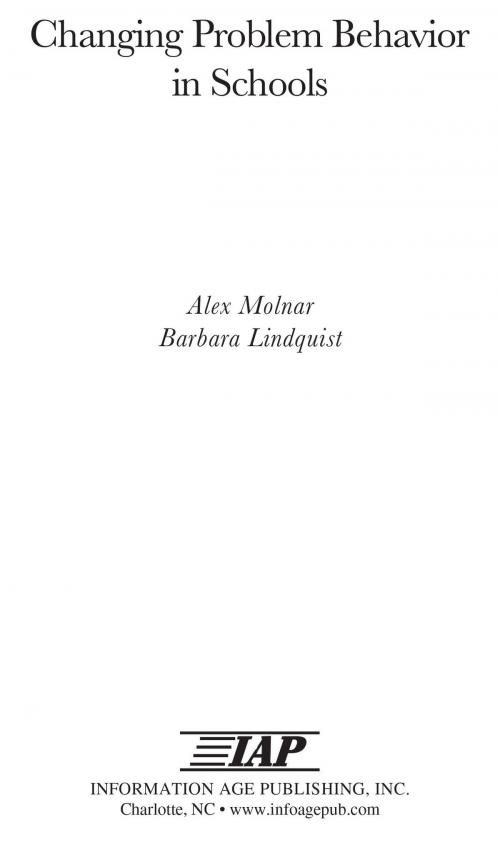Changing Problem Behavior in Schools
Nonfiction, Reference & Language, Education & Teaching, Special Education, Socially Handicapped, Higher Education, Social & Cultural Studies, Social Science| Author: | Alex Molnar, Barbara Lindquist | ISBN: | 9781607521563 |
| Publisher: | Information Age Publishing | Publication: | November 1, 2009 |
| Imprint: | Information Age Publishing | Language: | English |
| Author: | Alex Molnar, Barbara Lindquist |
| ISBN: | 9781607521563 |
| Publisher: | Information Age Publishing |
| Publication: | November 1, 2009 |
| Imprint: | Information Age Publishing |
| Language: | English |
(orginally published by JosseyBass 1990) Changing Problem Behavior in Schools presents an innovative approach to dealing with classroom behavior problems that can be used successfully by teachers as all grade levels, counselors, and administrators. The authors draw on techniques and strategies developed by family therapists to show how behavior can be changed and chronic problems eff ectively addressed. They off er numerous examples—drawn from the authors’ research on over two hundred cases—to illustrate problemsolving methods used successfully in classrooms, lunchrooms, and a variety of other school settings and situations. They suggest ways to build on successes and maintain an ongoing system for handling problem behavior. And they provide guidelines for analyzing unsuccessful attempts at changing behavior and off er advice on how to handle relapses. The book examines ways to overcome a wide range of student problems, such as fighting, sleeping in class, and tardiness. It also includes advice on solving staff relations problems such as disagreements over student placement — as well as problems between the school and the community such as a lack of cooperation from parents. A valuable resource section includes practice activities that provide stepbystep instructions for applying each of the book’s specific problemsolving techniques in the school or classroom. The approach to problem behaviors in the school described in this book is called "ecosystemic" because problem behavior is viewed as a part of, not separate from, the social setting within which it occurs. The book is divided into three parts. The three chapters in Part One describe the ecosystemic framework used to explain problem behavior. Chapter 1 analyzes how social, personal, and professional factors influence individuals' perceptions of events and contribute to keeping their behavior in problem situations from changing. Chapter 2 describes the usefulness of the concept of ecosystem and explains how problems and solutions are viewed from an ecosystemic perspective. Chapter 3 focuses on how to recognize and use ecosystemic clues to help develop the flexible approach to problem solving. Part Two of the book, consisting of chapters 4 through 9, presents ecosystemic methods for promoting change in problem situations. Each chapter is devoted to a different ecosystemic technique. Each chapter follows the same format: the technique is described, case examples are presented and discussed, and the essential elements of the technique are reviewed. The three chapters in Part Three encourage readers to implement techniques from Parts One and Two. A resource section concludes the book.
(orginally published by JosseyBass 1990) Changing Problem Behavior in Schools presents an innovative approach to dealing with classroom behavior problems that can be used successfully by teachers as all grade levels, counselors, and administrators. The authors draw on techniques and strategies developed by family therapists to show how behavior can be changed and chronic problems eff ectively addressed. They off er numerous examples—drawn from the authors’ research on over two hundred cases—to illustrate problemsolving methods used successfully in classrooms, lunchrooms, and a variety of other school settings and situations. They suggest ways to build on successes and maintain an ongoing system for handling problem behavior. And they provide guidelines for analyzing unsuccessful attempts at changing behavior and off er advice on how to handle relapses. The book examines ways to overcome a wide range of student problems, such as fighting, sleeping in class, and tardiness. It also includes advice on solving staff relations problems such as disagreements over student placement — as well as problems between the school and the community such as a lack of cooperation from parents. A valuable resource section includes practice activities that provide stepbystep instructions for applying each of the book’s specific problemsolving techniques in the school or classroom. The approach to problem behaviors in the school described in this book is called "ecosystemic" because problem behavior is viewed as a part of, not separate from, the social setting within which it occurs. The book is divided into three parts. The three chapters in Part One describe the ecosystemic framework used to explain problem behavior. Chapter 1 analyzes how social, personal, and professional factors influence individuals' perceptions of events and contribute to keeping their behavior in problem situations from changing. Chapter 2 describes the usefulness of the concept of ecosystem and explains how problems and solutions are viewed from an ecosystemic perspective. Chapter 3 focuses on how to recognize and use ecosystemic clues to help develop the flexible approach to problem solving. Part Two of the book, consisting of chapters 4 through 9, presents ecosystemic methods for promoting change in problem situations. Each chapter is devoted to a different ecosystemic technique. Each chapter follows the same format: the technique is described, case examples are presented and discussed, and the essential elements of the technique are reviewed. The three chapters in Part Three encourage readers to implement techniques from Parts One and Two. A resource section concludes the book.















